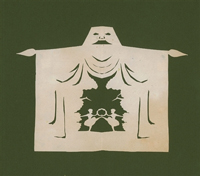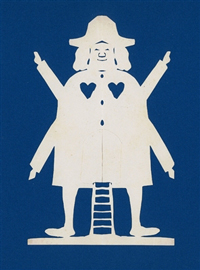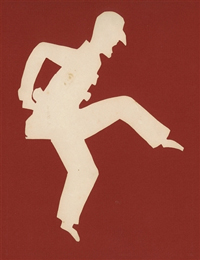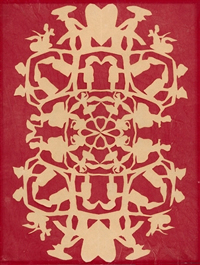
Hans Christian Andersen and the Art of Cut Paper
He had one really beautiful accomplishment, which was the cutting out in paper, with an ordinary pair of scissors, of lovely little figures of sprites and elves, gnomes, fairies and animals of all kinds which might well have stepped out of the pages of his books.

Hans Christian Andersen was recognized among his friends and acquaintances not only as a writer, but also as a talented artist. Instead of participating in dances and card games with adults at social gatherings, he enjoyed surrounding himself with children who paid rapt attention to his stories while he snipped and cut paper. As a friend recalled:

When he had ended his story (or had it ended because he had finished cutting the paper?), he spread out in front of us a whole series of cut out ballet girls who were holding each other by the hand, their feet in the air, and Andersen delighted at the success of his venture. He took more pleasure in our praising him for this than in the impression his story had made on us.
[Memories of Wilhelm von Kaulbach and his Household], 1921, p. 105.
As in his stories, Andersen depicted easily recognizable figures in his paper cuts. These representations were never exactly the same. He would also make cut outs to recount his travels. For example, Andersen gave the English writer William Francis Ainsworth a series of dancing dervishes that he fashioned while telling of his trip to Constantinople. The artist would also occasionally create remarkably intricate bouquet holders. In a letter to a friend in 1867, Andersen suggests that before children attempt to write stories, they should first “learn to cut out [because] that is the very beginning of creativity.” For him, this was a way of working out other artistic endeavors and also served as a means of escaping boredom.

As a result of his great fame, Andersen’s paper cuts, drawings and decoupages were treasured by their owners. Individuals often would paste his cut outs into books as illustrations. These whimsical and improvised artworks were motivated by the same unbridled imagination that characterized his written stories and can be considered fairy tales in their own right.
Hans Christian Andersen’s talent did not go unnoticed by European monarchs. King Maximilian II of Bavaria was such a fan that he invited Andersen to his castle in 1854. The Danish visitor noted in his diary that he “bound a bouquet for the queen and cut out a paper with swans to place around it” (Diary of Hans Christian Andersen, June 20, 1854). In 1872, King Christian IX of Denmark purchased paper cut bookmarks the artist had donated for a benefit bazaar.
In addition to paper cutting, Andersen was adept at drawing and decoupage and often made picture books for the children he was closest to. Along with the pair of long heavy scissors he carried at all times, the artist was always on the lookout for advertisements, illustrated magazines, book covers, and broadsheets to incorporate into these illustrated volumes.
Hans Christian Andersen, the writer, was so enamored of this artistic medium that he even created characters in his stories noted for their ability to make paper cuts.